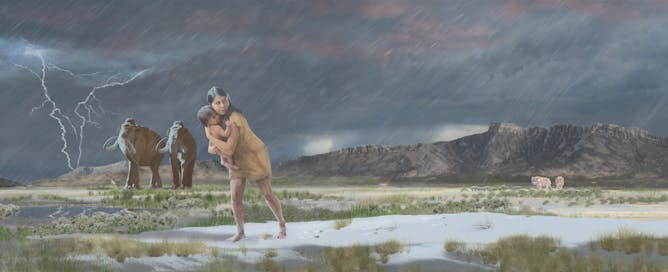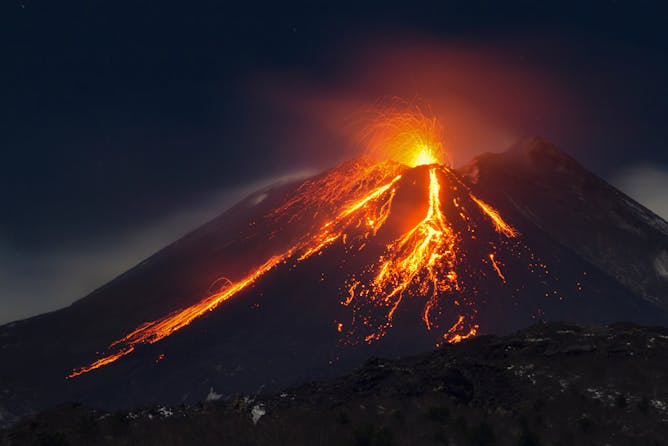|
|
|
|
Footprints on the sands of time are not made by sitting down. So it is no wonder that the longest trackway of fossil footprints ever discovered, dating to between 11,550 and 13,000 years ago, was made by a very determined individual rushing through a hostile landscape with very hungry predators around them.
An international team of scientists discovered the footprints, spanning more than 1.5km in a straight path, in a dried-up lake bed in the White Sands National Park, New Mexico. Now, they have finally been deciphered and two of the team have explained the findings for us.
By analysing the shape and structure of the tracks, the scientists uncovered that the trackway was most likely made by a woman carrying a young child. For some reason, she rushed through the muddy field at an impressive speed. She then returned the same way without the toddler, and may have discovered that both a sloth and a mammoth had crossed her path in the meantime.
Fast forward some 13,000 years and another determined individual, RuPaul, has made an important mark by helping turn an underground anti-capitalist art form into a lucrative, mainstream industry through his reality show “Drag Race” and the power of social media.
Meanwhile, eight-year-old Lena finds out how we can tell that a volcano is going to erupt in the latest article in our Curious Kids series.
|
Miriam Frankel
Science Editor
|

|
|

A prehistoric woman with a child have left behind the world’s longest trackway.
Matthew Robert Bennett, Bournemouth University; Sally Christine Reynolds, Bournemouth University
Some 13,000 years ago, an adult carrying in a child walked 1.5km in mud at great speed in the presence of hungry predators.
|

The contestants of the first Canadian Drag Race.
Matt Barnes
Zeena Feldman, King's College London; Jamie Hakim, University of East Anglia
How Ru Paul's Drag Race turned an underground anti-capitalist art form into a lucrative multifaceted mainstream industry
|

Mount Etna erupting.
Tomarchio Francesco/Shutterstock
Ian Skilling, University of South Wales
Volcanoes give lots of clues which help scientists work out if they are about to erupt.
|
Environment + Energy
|
-
Matthew Adams, University of Brighton
Why structured contact with nature, rolled out with government support, will go a long way to solving the psychological distress of coronavirus.
-
Fred Windsor, Newcastle University
The ghosts of our industrial and agricultural past continue to haunt freshwater ecosystems today.
-
Ravindra Jayaratne, University of East London
Indonesia has a warning system for tsunamis generated by earthquakes – but not volcanoes.
|
|
Arts + Culture
|
-
Nikolai Duffy, Manchester Metropolitan University
The Nobel committee hailed her "unmistakable poetic voice that with austere beauty makes individual existence universal".
-
Adam Behr, Newcastle University
For a decade after they met as teenagers, Lennon-McCartney was the most potent songwriting partnership in pop music.
-
Una Murphy, Coventry University
Independent community publishers are helping to restore trust in journalism - but they need support.
|
|
Politics + Society
|
-
Susanne Jaspars, SOAS, University of London
The World Food Programme can't stop hunger on its own – that also requires political action.
-
Alan Bradshaw, Royal Holloway
Now that this new way of living is more than just a passing phase, history has never been more open.
|
|
Business + Economy
|
-
Gavin Brown, University of Liverpool
In quick succession, UK has banned certain crypto derivatives trading and the owners of leading exchange BitMex have been indicted on criminal charges.
|
|
Health + Medicine
|
-
Ieuan Cranswick, Leeds Beckett University
Social media and changing ideas about masculinity are making more and more young men believe their body is too small, skinny or insufficiently muscular.
|
|
| |
Featured events
|

|
Online, Leeds, Leeds, LS2 9HD, United Kingdom of Great Britain and Northern Ireland — University of Leeds
|

|
Swansea University , Singleton Park, Swansea, Swansea [Abertawe GB-ATA], SA3 3DX, United Kingdom of Great Britain and Northern Ireland — Swansea University
|

|
Sustainable Places Research Institute, Cardiff University, Cardiff, Cardiff [Caerdydd GB-CRD], CF10 3BA, United Kingdom of Great Britain and Northern Ireland — Cardiff University
|

|
Aston University, Aston Triangle, Birmingham, Birmingham, B4 7ET, United Kingdom of Great Britain and Northern Ireland — Aston University
|
|
|
|
| |
| |
| |
| |
| |
|
|
|
|
|
|
|